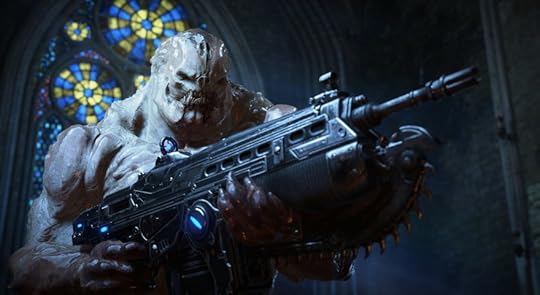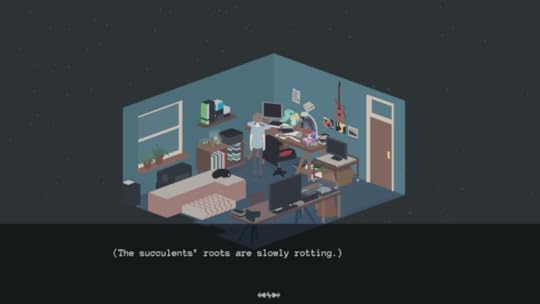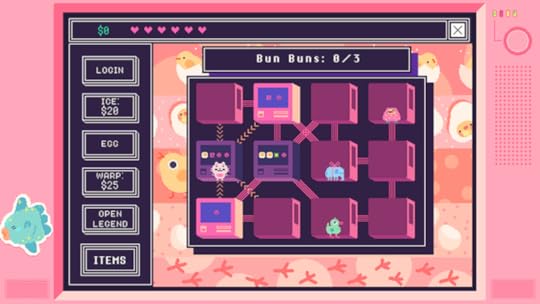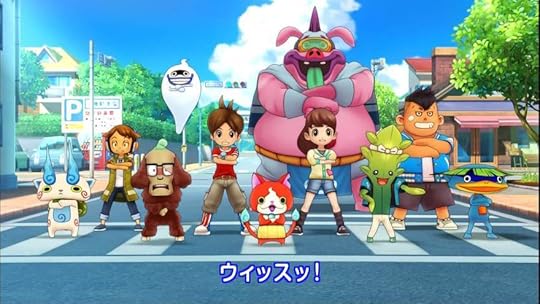Kill Screen Magazine's Blog, page 44
October 11, 2016
Gears of War 4 tries to cover up its battle scars
Two moments stick out from Gears of War 4.
In one, a geyser of blood shoots from the exoskeleton of an enormous, crablike Corpser as the Hammer of Dawn—a satellite-guided laser—rains a beam of molten death down upon it. Fountains of gore flow from the creature like a waterfall while serious, beefy dudes in massive armor run accompanying waves of monsters through with a typhoon of bullets.
In another, later scene, sparks fly off a metal-plated security robot as new protagonist JD Fenix plinks it apart with a submachine gun. He makes lighthearted, Whedon-esque quips to his pals and wears distinctly normal person clothes—khaki work pants and a rolled-sleeve sweatshirt—under his protective chest plate.
The first scene is from Gears of War 4’s prologue, which consists of a few short levels recapping important events from the original Gears trilogy. The second recurs throughout the early part of the game, as JD is pursued by an automated military deployed by the same Coalition of Ordered Governments (COG) that his dad, Marcus Fenix, fought at the vanguard of in past games. This juxtaposition is meant to show how different Gears of War 4 is from what’s come before—how JD isn’t, like his father, the personification of a militarized society that values nothing as much as overwhelming martial force.
///
“Thankfully, COG armor’s a little lighter these days,” JD Fenix says while exploring a decrepit museum. The exhibit, which was a raging battlefield only a few moments earlier, depicts both his world’s recent military history and the events of the original Gears of War trilogy. Little dioramas show skirmishes between overgrown soldiers, weapons are propped up in display cases, and, in one, a set of bulky armor of the sort worn by past Gears characters is displayed.
Gears of War is a little lighter these days, in a lot of ways. In a literal sense, JD and his two companions—fellow military deserter Del and rebel fighter Kait—wear less equipment and move around the battlefield a bit quicker than their enormous predecessors. But, the game is lighter in a larger sense, too. As non-regular military, JD and Co. aren’t an organized military bludgeon like Marcus and his COG squadmates. They are, instead, a nimble guerilla-style group of fighters without the might of a militarist government supporting their every move.
no substitute for good, old-fashioned blood and guts
This change in focus initially holds a lot of promise, especially in its positioning of the COG—the series’ former heroes—as the new enemy. JD and Del have abandoned their authoritarian government and come to live with Kait and other “Outsider” dropouts in an idyllic commune, finally fulfilling the anti-war sentiment that the prior games hinted at (there’s a reason those tough guys cried, grumbled, and raged between firefights) but never fully developed. The COG, now represented by mindless robots, propaganda posters, and the aging husks of the same bloodthirsty Gears soldiers who defeated the Locust monsters of the original trilogy, has become the totalitarian state that it always promised to be. Fighting against it, shooting down their armies of steel machines and raiding COG outposts to support the Outsider commune with pilfered government tech, is the logical next step for the series.
Before too long, though, in an implicit understanding that the electric sparks and splashes of oil that fly from chainsawed enemy bodies are no substitute for good, old-fashioned blood and guts, Gears of War 4 shies away from its promise, abandoning its earlier feint at subversion to opt instead for a more familiar kind of story.
///
JD Fenix makes quips. He never growls. As JD chainsaws through one of the game’s recurring, mucous-gated barriers, he affably sputters, “Aw, I hate this. Aw, aw, aw!” When he scoops up ammo from the ground, he happily calls out, “Don’t mind if I do!” or grunts “Sweet.” JD is a hero in the Harrison Ford mold—a winking rapscallion who’s tough enough to weather inhuman conditions, but still sufficiently down to earth to complain about his discomfort as he does so.
JD is the fucking worst.
He’s tolerable in Gears of War 4’s early acts, when the lightness of his banter is matched by the inconsequential violence of shooting robots and Robin Hood-ing gear from a government outpost. Before long, though, the plot attempts a darker bent, introducing monsters called the Swarm, reuniting JD with his estranged dad Marcus, and leading the group on a life-or-death rescue mission to rescue Kait’s mom.
At first, the shift from easygoing romp to horror-lite monster fighting seems appropriate. The autumnal feel of the entire game—and the eerie, haunted house vibe of the dead leaves, grand stone forts, and enormous white moon that fill the single night over which a large portion of the events take place—lends a nice Halloween feel to the introduction of some gnarly creatures. The Swarm are noxious—similar in shape, but texturally nastier than the old trilogy’s Locust monsters. There are a handful of amphibian varieties, but the most common enemies are Locust-style creatures, whose rocky scales have been replaced by painfully glistening reddish-white skin that makes them look like animated infectious wounds. As the characters track down the source of the threat, they end up exploring hellish spaces where crumbling Old World stonework and sprawling industrialized mineshafts are lined with ulcerous incubating pods (which burst with fluid and, occasionally, a tiny feral monster when punctured), pulsing intestinal vines, and the slumped skeletons of fallen soldiers.
In these sequences, the player’s weaponry finally finds appropriate targets. As the robots are replaced by the Swarm, the series’s trademark chainsaw bayonet gets to cut into monsters whose festering bodies are gross enough to be worth the effort; the shotgun, booming like a cannon, starts finding wonderfully disgusting feedback as flesh and blood enemies explode with a sound like a bag of chicken livers hitting the windshield of a speeding car. It becomes obvious here that Gears is best when it’s brutal—a teenager’s notebook depiction of heavy metal post-apocalypse.
Gears 4 takes only half measures
But the outsized nastiness of Gears’s combat has always been matched by equally ridiculous characters. JD, Kait, and Del, while decently suited as the PG-13 revolutionaries the opening demands, are too earnest, jovial, and just plain soft to hang with the snarling monsters and viscera-soaked battlefields of the rest of the game. (Kait, who sells a world-weary viciousness better than either of the boys, comes closest to making the new approach work.) Gears is a world so over the top that it requires superhuman characters to offer the player a proper entry point.
This is never more apparent than in the game’s most memorable scenes, which feature the return of characters like Marcus Fenix, now older, more restrained, but only slightly less of the human-shaped Y chromosome he was in the past. He’s of the old school, which Gears 4 largely seems ashamed to perpetuate outside of guest appearances and the excellent online modes—a decent enough competitive option called Versus and Horde, where players fortify an area and defend it against increasingly overwhelming waves of enemy siege attempts. Free from the narrative, old characters return to fight forever, saying nothing but beautifully stupid one-liners as they shoot and cut and punch in an eternal Valhalla.
Otherwise, Marcus is intentionally presented as a dinosaur, his hyper-masculine posing depicted as being as outmoded as his faded, off-brand Diesel do-rag. If there was a real rejection of what Marcus and the original Gears soldiers stood for in this latest entry—if the subversion hinted at in the game’s opening found real articulation—it would be easier to accept the story’s tonal fumbling. But, Gears 4 takes only half measures. It discards a lighthearted adventure premise for another fate-of-humanity monster invasion. It gives up on the anti-militarist bent of its early fight against the COG for another plot about soldiers trying to save humanity.
Most discordant, though, is the attempt to humanize JD, its principle tough guy, by replacing a caricature of manliness with a subtler and less immediately ridiculous one. While less overtly masculine than his father, JD still stars in a game where the only same-age woman in his proximity is fated to be his girlfriend. He still saves the day by being the craftiest, hardest guy around. He may reject the violence of the COG and his father outwardly, but, aside from taking himself less seriously, he’s really not very different from them at all. He may attempt to come across as someone other than the kind of man who’s born into such a violent, militant world, but doing so just leaves him confused and far less effective than he could be. Like Gears of War 4 itself, he’d be stronger if he fully accepted what he is.
For more about Kill Screen’s ratings system and review policy, click here.
The post Gears of War 4 tries to cover up its battle scars appeared first on Kill Screen.
October 8, 2016
Weekend Reading: The Ugly Truth
While we at Kill Screen love to bring you our own crop of game critique and perspective, there are many articles on games, technology, and art around the web that are worth reading and sharing. So that is why this weekly reading list exists, bringing light to some of the articles that have captured our attention, and should also capture yours.
///
Brutalism’s Aesthetic Legacy, Darran Anderson, White Noise
A stain in some cities, a sight in others. Brutalism has touched many capitals in the last century, but as far as how they’ll be appreciated, Darran Anderson explains how its legacy will be especially “love it or hate it.”
The Internet Is No Place For Elections, Mike Orcutt, MIT Technology Review
It was once thought that the internet could be the answer for so many voting woes, accessibility to polls and motivation for youth engagement chief among them. But having crossed a certain threshold for official enthusiasm for online voting, the climate of elections and digital security come with substantial second thoughts, Mike Orcutt reports.
Talking in Circles, Nick Pinkerton, Film Comment
Critics writing for posture isn’t new, the large network conversation that turns criticism into tides is. Less than devil’s advocacy, Nick Pinkerton talks about the transformation of cinematic commentary in the shadow of social media.
Passing away earlier this year, poet Max Ritvo will have his first book, Four Reincarnations, published posthumously. In a candid conversation, Slate’s Shon Arieh-Lerer and Andrew Kahn speak with Ritvo about death, his work, and how it might live on without him.
The post Weekend Reading: The Ugly Truth appeared first on Kill Screen.
October 7, 2016
Pac-Man Championship Edition 2 is a remix too far
Things have been looking up for Pac-Man lately. Pac-Man 256 made a huge splash on phones last year, and the gluttonous pie chart recently showed up in several collaborations with Google, including map mods and playable Doodles. There was that dreadful Adam Sandler movie too, which, quality aside, did effectively remind the general public that Pac-Man still exists and still really enjoys eating things.
motivated more by the need to reinvent than improve
This modern-day Pac-Man resurgence was spurred on by its original creator, Toru Iwatani, back in 2007 with the release of Pac-Man Championship Edition (Iwatani’s final game before his retirement). Pac-Man CE took the fundamental elements of the original 1980 Pac-Man—mazes, ghosts, power pellets—and remixed them into a high-score challenge contained within tight, five minute chunks. The CE formula was further remixed into the blissful chaos of Pac-Man CE DX (2010) with its ghosts trains and neon-bathed EDM trappings. CE DX was a high watermark for Pac-Man and set an example of how to effectively retool an old arcade game for a new age. It succeeded where so many classic coin-op hits faltered. Bomberman: Act Zero (2006), anyone?
Suffice to say, the new sequel, Pac-Man Championship Edition 2, has a lot to live up to. Unfortunately, in remixing the remix of a remix, Namco’s latest spin feels obligatory, as if motivated more by the need to reinvent than improve. CE 2 might be an original take on Pac-Man, but it’s one that seems to fundamentally misunderstand what makes a remix effective.
One of the most successful elements of Pac-Man CE and CE DX is the way those games perpetuate constant action, reworking halves of the playfield mazes in real time, keeping you on the move constantly. In contrast, CE 2 operates in fits and starts. The game does away with the on-the-fly maze reworks, instead stopping everything to vault Pac-Man onto totally fresh boards. Eating chains of ghosts is automatic now, meaning that when you devour the head of a lineup, the camera zooms in, cropping out parts of the maze you’d otherwise keep an eye on, leaving you twiddling your thumbsticks until the final ghost is eaten and you regain control. And, not only does using bomb items launch all ghosts back to their starter tank like before, they also shoot Pac-Man back to his initial position in the center of the maze. Both the ghost and Pac-Man resets have their uses, but in inextricable combination one of those actions is always either unnecessary or counter-intuitive. For example, if you’re close to finishing off a string of Pac-dots in a far corner of the maze but find yourself pinned between ghosts, you can bomb it all to hell and expel the ghosts, but you’ll be expelled from your immediate objective as well.
Some enthusiastic fans of Pac-Man CE DX have labeled the game “Pan-Man on drugs.” Comparatively, CE 2 is a placebo. Even aesthetically, the game is a shell of its predecessors: the ineffectual “minion” ghosts are green outlines of ghost shapes—ghosts of ghosts. The major twist in CE 2 is that Pac-Man can safely bounce off a ghost three times before they get angry and begin their pursuit. This new-school leniency is a concession to having a glut of unavoidable minion ghost lines clogging up the maze, and in practice turns a game of precision and timing into a bumper car free-for-all. You almost never have to avoid, much less run away, from the ghosts, which renders them nothing but automated consumption fodder.
a Frankenstein’s Pac-Man
Pac-Man CE 2’s new Adventure mode underwhelms on its premise as well. It offers a series of timed challenges featuring the same basic loop as the rest of the game, just in smaller doses. The “boss fights” against giant ghosts are all façade, merely serving up a non-interactive cutscene at the end of a series of mazes. While Pac-Man CE 2 is, much like the rest of the CE series, more linearly structured than classic Pac-Man, it’s the first time in a CE installment where I felt like a cognitively-adept lab rat while playing it. You’re given a line of Pac-dots and rarely a reason to deviate from the path.
I find that, in music, the best remixes are the ones that either build up simple tracks or strip down complex ones. The creators of Pac-Man CE 2 had the difficult task of remixing a game that has already been expanded upon and reworked to the point of refinement, and they chose to pile on the complexity anyway. The result is a Frankenstein’s Pac-Man—a mess of features and modes that, despite all the power pellets and fruit and ghosts, still left me feeling hungry.
For more about Kill Screen’s ratings system and review policy, click here.
The post Pac-Man Championship Edition 2 is a remix too far appeared first on Kill Screen.
Really Bad Chess is bad in all the right ways
You’re taking a walk in Central Park. The sun is shining down on you, a stark contrast to the cool autumn wind that tickles the back of your neck. It’s a reminder that change is coming. As you stroll past the row of chess tables, you see two elderly men hunched over and glaring at each other with an intensity that startles you. As you approach, you notice that there are chess pieces sprawled everywhere. The two men look exhausted. You walk closer to see that the board is full of Queens. Nothing but Queens. One of the old men shakes his head in defeat. “Who could be res-pawn-sable for this?” The other spots you eyeballing the situation and sighs as if he’s seen more than two world wars. “It’s Really Bad.” he explains. “It’s Really Bad Chess.”
///
Chess has been around for nearly 1500 years. Could you imagine the monotony of playing the same game with the same mechanics and no variation for millennia at a time? Gone are the days of stale rules and regulations! Clear your board and throw your pieces away, because starting October 13th Zach Gage will be releasing Really Bad Chess for iOS. Despite the title, the reimagined classic is described as being “just like chess, but with totally random pieces. Try eight Knights, four Bishops, and three pawns—why not?” Indeed, why not?
open the door to an entire new world of chess
Even if you play chess quietly with no interruptions or have only tried it once, the small change in how you play is sure to provide a new experience. Total mayhem might ensue. Wipe away the image of two old men playing a peaceful game of chess at the park because Really Bad Chess is going to “open the door to an entire new world of chess.” Relationships will fall apart. Children won’t be able to stop crying. Buildings will catch on fire as the foundations of regular chess crumble to the ground because there are three Queens ruling the board in all of their untamed glory. It sounds pretty nice.
The pieces and the moves are the same, but their starting location on the board is different each and every game. Gage explains that “Really Bad Chess removes these boring restrictions and flips chess on its head.” It’s something that’s been tried before such as in Chesh. But competitive chess players can always do with a new challenge, abandoning their usual strategies, while something like Really Bad Chess should be great for beginners to learn about the joy of landing a checkmate without having to study openings.
Really Bad Chess comes out for iOS on October 13th. Learn more about it here.
The post Really Bad Chess is bad in all the right ways appeared first on Kill Screen.
29 will tell a personal story through otherworldly dioramas
Something is off in a flat in South London. It’s not necessarily in the vegetables growing rot on the kitchen counter, or the new Guillermo Del Toro-inspired roomie, or the soft sounds of banging that seem to radiate through paper-thin walls. It might be a combination of those traits, the malaise of the freshly graduated combined with the claustrophobia of apartment life.
29 is an upcoming “semi-autobiographical magical realist point and click, focusing on two transgender non-binary people,” Ao and Bo. The characters are loosely based on the creators of the project, Tom Davison and Hana Lee (also the creators of Friary Road). 29 is meant to be viewed as the first chapter in a larger work that’ll be called “No Longer Home,” one that will further explore the concepts of this initial game as well as the characters gender identities.
a finely illustrated work that unfolds like a diorama
“We’re not interested in using gender as part of the plot or have Ao and Bo defined by them, but instead it being just part of who they are,” they write, “Bo and Ao both use they pronouns and while showing the game at events we’ve had many people misgender them. We think things like this show why it’s so important to have our genders represented in media.”
There is something, not an unease but an otherworldliness, that perpetuates the piece—a finely illustrated work that unfolds like a diorama around the subtle sounds of a cat’s purr. This unnatural/naturalness follows through in the crafting and design of the apartment and characters, the “flat-shaded colours” that call to mind a recent appreciation of Tom’s of the work of Eran Hill and the psychogeography of place. Hana points to the characters in Pan’s Labyrinth () as an influence: “you can easily familiarise yourself with the monsters to the point where their existence feels natural.”
You’ll be able to play a beta version of 29 on itch.io soon.
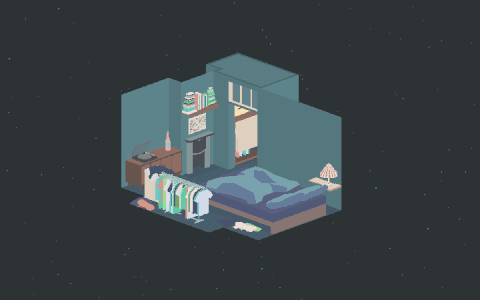
The post 29 will tell a personal story through otherworldly dioramas appeared first on Kill Screen.
The videogame world of HBO’s Westworld
Based on the 1973 film by Michael Crichton of the same name, HBO’s Westworld has taken the original’s hackneyed premise of a couple tourists escaping from the Delos Corporation’s various time-focused theme parks (Medieval World, West World, and Roman World), and shifted it into a refined look at what it means to be human, the nature of memory, and the true extent of humankind’s appetite for depravity.
With “over 100 interconnected storylines” programmed into the park’s daily routine, the world they’ve created resembles a heightened version of the storytelling that players of modern RPGs have grown accustomed to. That connection to videogames isn’t a stretch, as writers and showrunners Jonathan Nolan and Lisa Joy told Vice that they were inspired by BioWare’s Skyrim (2011) and Rockstar’s Red Dead Redemption (2010). In particular, they draw on the sprawling western landscape o the former, full of morally-conflicted antiheroes and villains, and the latter’s myriad plot lines just waiting to be discovered by players
that software update is causing unintended consequences
The result is a story not unlike what the development teams on those games must have gone through when building their worlds. Stars Jeffrey Wright and Anthony Hopkins wrestle with how best to maintain the illusion of reality to their players, termed “visitors,” while also keeping those story lines moving. Of course, the main difference being that the developers at, say, Irrational Games never had to worry about the inhabitants of Rapture finding out that they’re not actually real and turning on them when creating BioShock (2007).
While Wright and Hopkins’ characters bemoan previous versions of robots that repeated themselves, broke down, or froze, they work to create a more fully-realized recreation of humanity, even going so far as to implement a software update creating the digital equivalent of memories. The series opens as that software update is causing unintended consequences, whether it’s a fly turning a sheriff into a gibbering mess or a homicidal maniac growing more bloodthirsty than expected.
In the first episode, “The Original,” we see how carefully-laid each of those story lines can be, as Delores, played by Rachel Evan Woods, proceeds through her scripted day multiple times, each with varying outcomes depending on who she runs into—all based around player interactions. In a scene that mirrors the way videogame players often gleefully discover ways they’re able to bend and break a game’s coding, a particularly high-stakes, emotive moment is cut short by a player’s clumsy interruption as he cackles away to his gawking wife.
While only two episodes are currently available, Nolan and Joy seems to have created a world that feels just as lived-in and fleshed-out as the interactive stories they drew inspiration from.
Westworld airs on HBO on Sunday nights at 9pm, and the first episode is currently online for free at HBO.com.
The post The videogame world of HBO’s Westworld appeared first on Kill Screen.
Butt Sniffin Pugs, because we all need to sniff more dog butts
There are hundreds of dog breeds, originating from different parts of the world, big and small, hairy and bald. However, I think we can all agree that pugs are one of the cutest dog breeds out there, right? Don’t answer that, as the Phoenix-based studio SpaceBeagles will back me up on this: the team is making a game about pugs sniffing each other’s butts. Yeah, you read that right, don’t worry, I’ll explain.
Now on Kickstarter, Butt Sniffin Pugs is a co-op exploration game where you roam around Central Bark in the middle of New Yorkie City, making little pug friends. You can just run around the park if you like, do your business in the corner, dig some holes, or simply interact with objects—the game can be as chill as that. But, you can also use your special “pug powers” to unravel mysteries and treasures within the pug world, in addition to treats, power ups, and in-game currency to upgrade your park and doghouse.
a stuffed pug butt that acts as the sniff button
You can visit fellow pugs as well, and help them solve puzzles, do activities together, or give them fancy items to decorate their own doghouse with. The game’s theme and playful interactions were inspired by games like Animal Crossing and Neko Atsume: Kitty Collector (2014), with the team focusing on making the game accessible to people of all ages.
All of this sounds great, sure, but SpaceBeagles has gone one step further as you can play Butt Sniffin Pugs using a butt-sniffing trackball controller. The controller contains two main parts, a giant trackball shaped as a tennis ball, which fits the whole dog theme, and a stuffed pug butt that acts as the sniff button, allowing for a “fully immersive pug experience.” Unfortunately, this controller can only be played with at events where the game is being shown, or if you’re one of the 10 people to throw down $1,500 at the Kickstarter. That’s an expensive dog butt.
Butt Sniffin Pugs is expected to release during the first half of 2018 for PC and PS4, with physical rewards arriving to backers between summer and fall of 2017. Find out more on its Kickstarter.
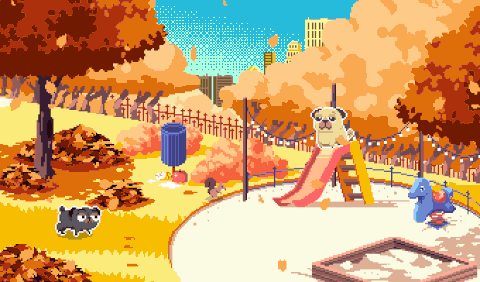
The post Butt Sniffin Pugs, because we all need to sniff more dog butts appeared first on Kill Screen.
Beglitched starts the cyberpink revolution
I struggle every Halloween to decide on a costume. I’ve dressed up as all the basics: a black cat, a vampire, a witch—twice. But Beglitched may have saved me the hassle this year. It has introduced to me a whole new concept: a cyberpink computer witch.
Now, the title computer witch itself would be cool enough. You could say, “thanks for that idea, Beglitched,” and be done. But the computer witches of Beglitched want you not only to know about them, but to become one of them. As such, they dump you in the middle of their cyberpink witching hour, surrounding you with sugary, pastel imagery of bunnies, pink donuts, and blue elephants in ribbons. It’s not the usual imagery you associate with hacking. But why the hell not? Lord knows we’ve had way too many “cool” dudes in hoodies and Guy Fawkes’ masks, with Matrix-style falling numbers behind them. You know, the type of stereotypical hacking world that efforts like Watch Dogs (2014) portray.
a witch who controls cyberspace
Beglitched is a game that throws all that away and says computers and hacking can be cute, too. It takes the cold greys and hard greens of computer culture and throws glitter all over it. It’s a game that presents hacking as only Lisa Frank—the 90s designer of neon unicorn-covered trapper keepers—could imagine it, where spam is literally a pixelated spam-on-toast humanoid thing with big kawaii eyes. But it’s also more than that.
At the center of Beglitched is the Glitch_Witch, who can not only hack, but “manipulate the fabric of the modern world” too. That a witch who controls cyberspace is the central character of Beglitched may be a bit of cheeky commentary on gender and STEM. Witches, as arbiters of chaos and insanity, were primarily deemed to be female in the Salem Witch Trials; 75 percent of those accused were female. Some scholars of hacktivism have noted that there are “very few accounts of female hackers and very little evidence that women have engaged in hacking,” perhaps connected to the fact that there are also “frequent accounts of online harassment and occasionally epic encounters with misogynist hackers.” Having a witch controlling (or reclaiming) a male-dominated field of computing and hacking is a significant, subversive narrative to insert in what superficially appears to be nothing more than a match-three-type puzzle game. It is only fitting, then, that the game’s cyberpunk world is slathered in pink.
It so happens that the Glitch_Witch is away when you start the game. And so it is that you, the player, must replace her temporarily by exploring a network called the Flowernet. Unfortunately, the Glitch_Witch’s powers have attracted a long list of enemies, and you’ll have to deal with them on her magical bubblegum-pink laptop that you accidentally stumbled upon. Maybe she planted it for you. Either way, you’re her clean-up crew while she’s away. Or, as the Glitch_Witch and her enemies dub you, her “leftclicker.”
As you explore the Flowernet, jumping from various nodes and secret folders, you confront and occasionally get chased by the Glitch_Witch’s rivals, who challenge you to hacking battles in order to prove their hacking prowess. These battles look a lot like puzzle games, something like a unique mix of Bejeweled (2001) and Minesweeper (1989). I had difficulty with these battles. The puzzle rules aren’t exactly intuitive, which isn’t helped along by the game only giving you instructive clues after you’ve royally messed up. It seems to be appealing to the idea that you’d learn better if you’re left to figure things out by yourself, but unfortunately that leads to frustration. Hexecutable previously addressed concerns with the steep learning curve of the game, but it looks like that curve is still very much there.
I asked a friend for help at one point, and even with both our heads together, it took us a while to discern the rules of the game. Especially because enemies have entirely different fight styles, and move across the puzzle board in a range of patterns. Normally, I’d appreciate the variation, which forces you to strategize new techniques to get the pieces on the puzzle board—or battle grid, as it’s called—to fall in a certain order, somewhat similarly to Tetris (1984). However, it’s a little hard to strategize when you don’t know the rules of the game in the first place. Some more clarity in terms of how enemy hackers move across the board, how to keep track of their movements, how to avoid taking damage, and how your own energy depletes with every move would have really helped.
once you’ve discovered the patterns, the game begins to get tiresome
At the same time, this lack of clarity helps formulate the narrative that you’re just a poor kid trying to take the place of a brilliant hacker witch, and that therefore you have no freaking clue what you’re doing. And it’s true that, once my friend and I finally began to discern the rules, all the pieces started to fall in place. Get it? Because you have to put the puzzle pieces in place? …Listen, Beglitched is a game that refuses to take itself too seriously and is full of adorable puns. It’s tongue-in-cheek all the way through and its borderline corny approach to humor is infectious. I mean, just look at the “Help” icon: it’s a freaking a paperclip wearing pink hipster glasses, reminiscent of Clippy, the old-school Microsoft Office assistant. Sadly, I had to click on it a lot of times.
You’d hope that, once you’ve figured out Beglitched’s puzzle system it would start to gain momentum. In fact, what happens is it starts to feel a little repetitive. And as you go deeper into the Flowernet, you encounter more and more enemies, and may at times feel overwhelmed by the sheer number of enemies. But even more overwhelming at times is the feeling of being bombarded by more and more of the same types of enemies—you’re almost always attacked by either hacker ducks, guard dogs, elephants, or Yeti-creatures—with the same kinds of tricks, and the same battle music. Because half the excitement of the puzzle is solving it, once you’ve discovered the patterns, the game begins to get tiresome. This is a fault that could be tied to its existence as a tile-based puzzle game; they all get tired after all. To its credit, Beglitched does try to avoid the trappings and limitations of its genre by having you face a super badass boss hacker at the end of every node. It’s a decent test of your skills up until that point, requiring a degree of mastery of what you’ve learned so far, but once again it falls back on repetition.
Fortunately, even in its low points, Beglitched’s aesthetic almost becomes a saving grace. Take a look at the enemy hackers and you’ll see they are adorable. Seriously: they appear on your battle grid as bouncing little pixel-bears (who also love puns), or iddy-biddy purple Yeti creatures, or plucky mice. And all of them, in their desperate need for revenge against the Glitch_Witch, reveal their insecurities about their own hacking skills and talents, which somehow makes them all the more loveable. You find yourself almost rooting for them, which in turn made me start to question the character of the Glitch_Witch, who I already half disliked for forcing me to drown in the chaos she left in her wake. Who is she that her disappearance has caused cyberspace and its hacker inhabitants, who revered her so deeply, to implode without her?
As I traveled from node to node, this line of inquiry grew in its urgency, and led to my communion with the other hackers—it felt like we were in this together. And in my desperate to quest to learn more about her, all I could find were hints at the Glitch_Witch’s true personality; for example, as you play along, you might find her “Secrets” folder, which contains hidden gems like this: “The secret to a lot of things is to just pretend they’re other things … Our sensations aren’t set in stone. And if they are, I bet someone has an uncle who can lend us a chisel.” These secret thoughts of the Glitch_Witch, or riddles, were both frustrating because they did not bring me any closer to finding her, but also intriguing for the same reason. It left me thinking: how the hell did this three-tile puzzle game evoke a strong emotional response in me? The game has a knack for subtly weaving the mystery of the Glitch_Witch in the backdrop of the puzzles, and it proves effective in driving you to keep battling forward.
Now, if you don’t mind, I need to assemble a pink and sparkly cyberpink witch costume. It’s nearly Halloween, y’know?
For more about Kill Screen’s ratings system and review policy, click here.
The post Beglitched starts the cyberpink revolution appeared first on Kill Screen.
October 6, 2016
That Dragon, Cancer is available on iOS today
That Dragon, Cancer was released back in January this year, shortly after my father’s cancer diagnosis. My first real brush with cancer, I clung to the game for guidance. That Dragon, Cancer didn’t necessarily tell me what to expect, but helped steer me through the things I needed to feel. I wished desperately that my parents would give it a try. But they wouldn’t—and not because they didn’t want to; they just really didn’t have a way to play a computer game (they’re tablet folks).
Amy Green, Joel’s mother and writer on That Dragon, Cancer, wasn’t surprised by that. “We have suspected for a while that our videogame, That Dragon, Cancer, may not have quite found its true audience yet,” Green said. That’s why the team is releasing the game on iOS for Apple devices, starting today. “Even people I’m really close to, like my best friend and my mom, haven’t played That Dragon, Cancer yet, because they had never downloaded a game onto a computer before.”

More people will meet Joel, not only within the iOS release, but with Thank You For Playing, too—the documentary film about the creation of That Dragon, Cancer. Thank You For Playing will air in the United States on October 24 on PBS.
That Dragon, Cancer may not have quite found its true audience yet
“On a personal level, it feels really satisfying to know that people that matter to me will be able to experience the game first hand,” Green said. “A lot of people have heard about Joel’s story but haven’t been able to experience what we created to memorialize him.” And that makes October a particularly special time for Green.
That Dragon, Cancer is now available in the Apple iOS App Store for iPhones and iPads. The game is also available for Windows, Mac, and Linux on Steam.


The post That Dragon, Cancer is available on iOS today appeared first on Kill Screen.
Yo-Kai Watch 2 taught me that emotions are a lie, but ghosts are real
I’ve been playing Yo-Kai Watch 2: Bony Spirits every night since I got it. Why Bony Spirits and not Fleshy Souls (the alternative version of the same game)? Because skeletons are cooler, I guess. At least, that’s my reasoning.
Yo-Kai Watch 2 comes only a year after the series’s first localization reached the West, following a lot of people labeling Yo-Kai Watch as being the “new” Pokemon (which was even a descriptor before the series ventured westward). As if Pokemon has been gone in the past few years—it hasn’t, and there’s even a new one coming out pretty soon.
All life’s petty problems caused by little nuisances of ghosts
Playing so much Yo-Kai Watch 2, I’ve found myself easing into its calming routine. Fetch quests, befriending local yokai, perfecting eating meals with my family, saving people from being inspirited (a possession that causes a person to do what a yokai inhibits). And it’s made me think: what if every strange thing we do, or feeling we have, is because of a looming yokai’s influence?
My sudden brush of needing to clean everything in sight, caused because a Brushido appeared, and not because I got stressed out seeing dishes in the sink. My terrible allergies actually signify the presence of a nasally Snotsolong, and not just being around nature. It’s a wonder, the thought of all life’s petty (and non-petty) problems not being caused by actual life things, but by little nuisances of ghosts—always curable by a kid running around with a magical watch.
That scenario would be a relief, to be perfectly honest. A Hungramp is cursing me to hover around my fridge, snacking on food that I shouldn’t while feeling guilty. A Spoilerina is just imploring me to accidentally spoil things for people like, you know, that crazy ending to Episode 3 of Luke Cage. This notion assigns away life’s smallest of problems and emotions to an outer force, when life’s accidents aren’t left to chance, illness, or personal fault. In fact, yokai inspiriting is the opposite of chance. A yokai has some business to haunt, just for fun, and you are the target. Better hope a magic watch-wielding kid is nearby to help.
Of course, yokai, in all likelihood, aren’t real. There aren’t nap-loving Lie-ins that cause me to sleep at random hours in the day. That’s just depression! I don’t know what yokai would cause me anxiety, maybe it’s a bunch of them teaming up to see how much I can handle. Sure, a lot of the problems that we face in our daily lives aren’t caused by yokai intervention. But I think confronting life’s problems as ultimately fixable, or at least finding coping mechanisms, helps. Just as Katie or Nate (the two playable characters) from Yo-Kai Watch 2 might throw themselves into battle to save another inspirited citizen, we can take it upon ourselves to tackle things as they come, as best we can. Yo-Kai Watch-enabled or not.
I didn’t play much of the first Yo-Kai Watch. When I took a trip to Japan earlier this year, I visited a Yo-Kai Watch pop-up shop in Tokyo. I’d also been to a Pokémon Center earlier in the week, and seeing the excitement in kids as they interacted with each shop, I understood that, if I were their age, I’d be happiest kid in the world too. I realized that Yo-Kai Watch is—like Pokemon was for me—the perfect game for kids. It might not click with all of us grumpy adults, but for children with not much to do but long to have a sense of freedom and to see and befriend monsters, Yo-Kai Watch is there. Plus, it has some decent life lessons about problem solving too.
Yo-Kai Watch 2 is available for 3DS now. Also this headline is a total joke. Emotions are real y’all.
The post Yo-Kai Watch 2 taught me that emotions are a lie, but ghosts are real appeared first on Kill Screen.
Kill Screen Magazine's Blog
- Kill Screen Magazine's profile
- 4 followers



